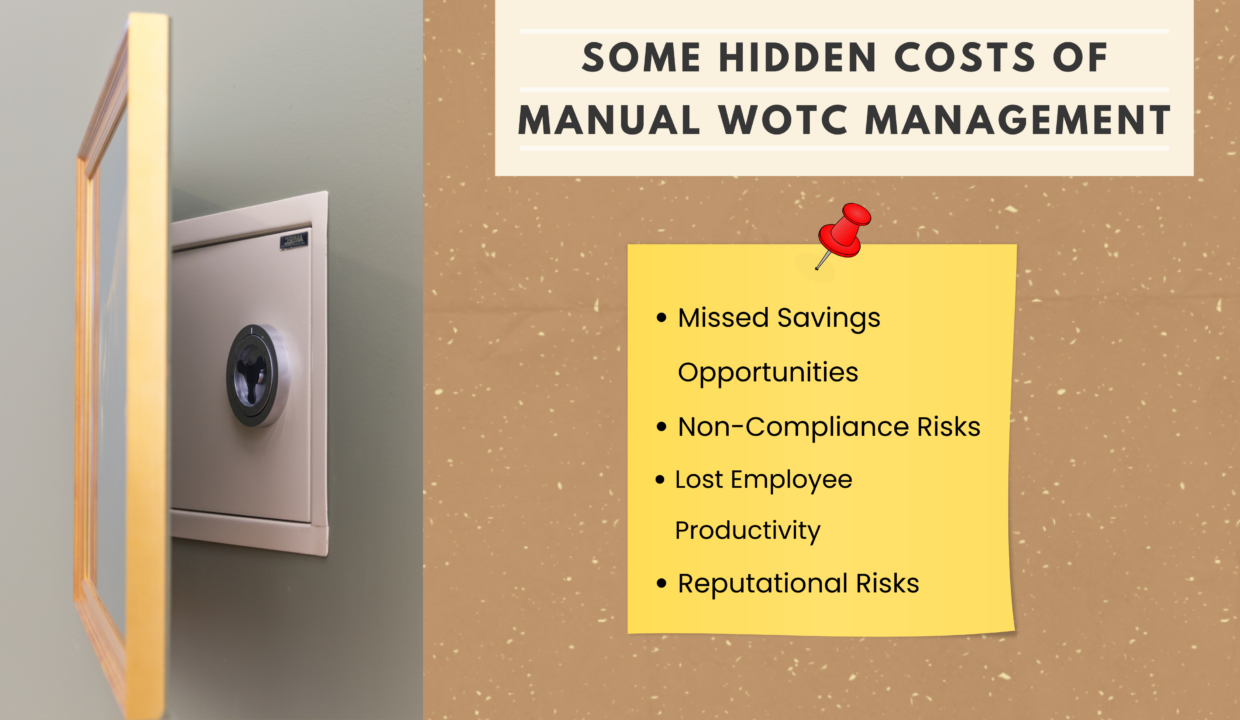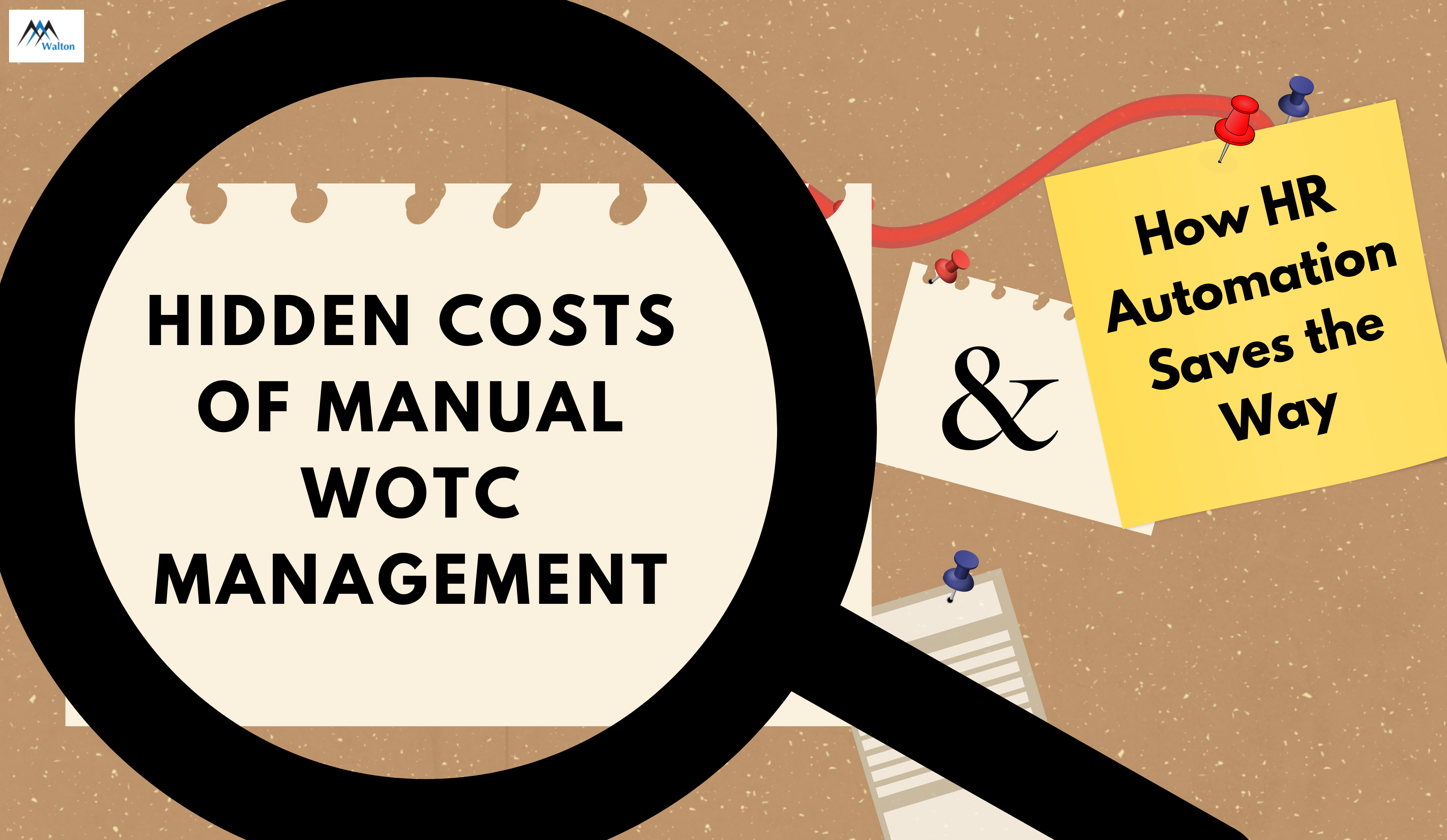Introduction
Managing the Work Opportunity Tax Credit (WOTC) manually can lead to a significant drain on business resources. WOTC offers businesses valuable tax savings, but if it’s managed without the aid of HR automation, the process becomes inefficient and costly. This blog explores the hidden costs associated with manual WOTC management and how HR solutions integrated with HR automation software can help businesses streamline processes and maximize savings.
What are the Challenges of Manual WOTC Management?
Managing WOTC without the support of HR automation presents a series of challenges that increase hidden costs:
1. Time-Consuming Processes:
Manual WOTC management involves gathering extensive employee data and verifying eligibility manually, which diverts HR staff from more strategic tasks. Each claim requires careful review and data entry, which can be a slow and inefficient process.
2. Risk of Errors
Since WOTC claims are complex and require precise data entry, errors are common in manual processes. These mistakes can result in missed claims, inaccurate submissions, or compliance issues, all of which negatively affect the business’s tax savings and can lead to costly corrections.
3. Tracking Eligibility Challenges
Without automation, HR teams struggle to efficiently track WOTC eligibility. Identifying which employees qualify for the tax credit is often done manually, which can lead to oversight and missed opportunities for claiming tax credits.
4. Administrative Costs
The administrative burden associated with manual WOTC management demands considerable HR resources. HR teams must invest time in filing claims and managing documentation, time that could be better used on higher-value activities, such as employee engagement or talent development.
Related Article: WOTC Explained: How Businesses Can Get Tax Credits for Hiring Veterans & More
What are the Hidden Costs of Manual WOTC Management?
Manual management of WOTC creates several hidden costs that are not immediately obvious:
1. Missed Savings Opportunities
Without automation, tracking and submitting WOTC claims becomes inefficient. Businesses may miss deadlines or fail to recognize eligible employees, resulting in lost tax savings that could have been claimed otherwise.

2. Non-Compliance Risks
Manual processes heighten the risk of non-compliance with IRS regulations. The lack of automated checks increases the chances of mistakes, leading to costly penalties, fines, or an IRS audit. HR automation tools ensure that all claims meet IRS requirements and are submitted on time.
3. Lost Employee Productivity
When HR staff is occupied with manual WOTC management, they have less time for important activities like talent acquisition, strategic planning, and employee development. This reduces the overall productivity of the workforce, potentially harming business growth and success.
4. Reputational Risks
Mishandling WOTC claims can damage a company’s reputation. If errors lead to fines or audits, it can reduce stakeholder trust and deter potential employees from joining the company. Proactive HR automation minimizes such risks, protecting both financial and reputational assets.
Related Article: How to Optimize Tax Credits with Integrated Payroll Solutions?
How HR Automation Saves the Day?
HR automation offers a powerful solution to these hidden costs by streamlining WOTC management:

1. Efficient Workflow
Automated systems make data collection, verification, and submission of WOTC claims faster and more accurate. By eliminating manual entry, HR automation reduces bottlenecks and accelerates the claims process, freeing up valuable HR time.
2. Real-Time Eligibility Tracking
With HR automation, businesses can instantly determine employee eligibility for WOTC, allowing HR teams to identify qualified employees and submit claims promptly. This ensures that no opportunities are missed and tax credits are maximized.
3. Error Reduction
Human error is significantly reduced when HR automation tools are used to handle WOTC claims. The system automates complex calculations, data entry, and compliance checks, ensuring that the claims process is accurate and in full compliance with IRS guidelines.
4. Cost Efficiency
HR automation reduces the need for manual intervention, allowing businesses to lower administrative costs associated with WOTC management and redirect resources to other growth-driving activities.
5. Scalable Solutions
HR automation offers scalability for businesses of all sizes. As the company grows, automation can easily be adapted to handle increasing volumes of WOTC claims, without the need to hire additional HR staff or increase administrative burden.
Conclusion
The hidden costs of manual WOTC management can be substantial, affecting a company’s bottom line and draining valuable HR resources. By adopting HR automation, businesses can streamline the Work Opportunity Tax Credit process, reduce administrative costs, and ensure compliance.
Walton Management offers specialized HR solutions and cutting-edge HR automation tools that make WOTC management seamless and efficient. Book an appointment to maximize your tax savings, reduce hidden costs, and optimize your HR solutions today by partnering with Walton Management. Visit Walton Management’s WOTC services to learn how you can save time and money while ensuring full compliance with WOTC regulations.

